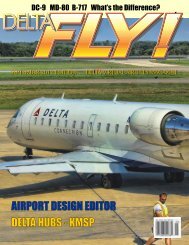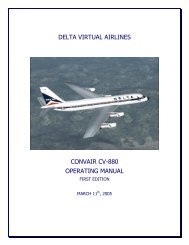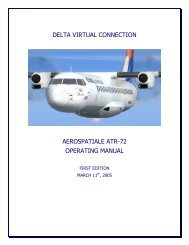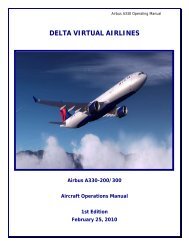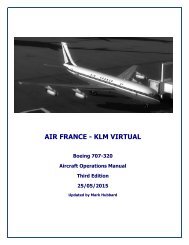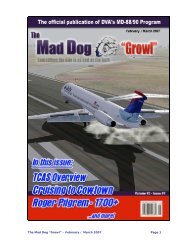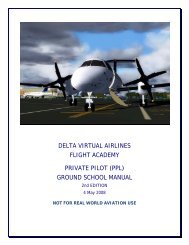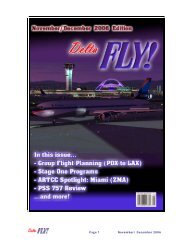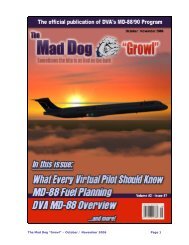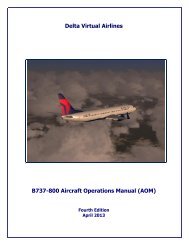The Mad Dog âGrowlâ âApril / May 2006 Page 1 - Delta Virtual Airlines
The Mad Dog âGrowlâ âApril / May 2006 Page 1 - Delta Virtual Airlines
The Mad Dog âGrowlâ âApril / May 2006 Page 1 - Delta Virtual Airlines
Create successful ePaper yourself
Turn your PDF publications into a flip-book with our unique Google optimized e-Paper software.
To counteract this, you will need to apply equal and<br />
opposite pressure to the rudder. <strong>The</strong> more power<br />
you add to the good engine, the more the aircraft will<br />
turn.<br />
In the event of a fire warning annunciation, the<br />
emergency checklists and procedures should be put<br />
into action. In this situation, the aircraft is stabilized<br />
and we are at level flight. Based on that, engine<br />
shutdown should be performed immediately by<br />
shutting off fuel to the engine. Following that, all<br />
bleed air, electrical and hydraulics from the injured<br />
engine should be isolated and the fire handle should<br />
be pulled to extinguish the fire. In the event of an<br />
engine fire, an engine restart should not be<br />
attempted unless the engine is critical for continued<br />
safe flight.<br />
<strong>The</strong> landing phase of the flight is normally the most<br />
critical. Doing so in the midst of an emergency<br />
makes things even more interesting. We will be<br />
hand flying the aircraft for the remainder of the flight<br />
to maintain complete control of the aircraft in this<br />
situation. When flying with one engine out, the<br />
aircraft well tend to turn towards the side of the failed<br />
engine. In this example, our #2 (right side) engine is<br />
out. As a result, the aircraft will try to turn to the left. I<br />
have tried to illustrate this using the airport runway<br />
as a reference in the image below.<br />
As shown in the diagram, only the #1 engine is<br />
powering the aircraft. We push on the left pedal to<br />
apply opposite rudder to maintain straight flight. <strong>The</strong><br />
aircraft will tend to drift to the right in this scenario,<br />
so we should line up slightly to the left of the runway.<br />
Winds will also be a factor and should be taken into<br />
account.<br />
Another thing to keep in mind during an engine out<br />
approach is your flap settings. Based on information<br />
I’ve read, the landing should be done at flaps 28.<br />
You will have less lift than normal, but you will be<br />
able to keep your airspeed up. Keep a close eye on<br />
your airspeed during the approach, as it does have<br />
the potential to drop quickly. Be sure to make small<br />
adjustments to power if necessary. In this crippled<br />
state, a sudden or major adjustment to power could<br />
seriously destabilize the aircraft.<br />
<strong>The</strong> <strong>Mad</strong> <strong>Dog</strong> “Growl” –April / <strong>May</strong> <strong>2006</strong> <strong>Page</strong> 11



